Halogen lamps: device, varieties, nuances of choice + review of the best manufacturers
Among the most popular light sources widely used for indoor and outdoor lighting, halogen lamps can be safely called. They consume more energy than fluorescent and LED, but surpass incandescent lamps in performance.
In the article we will talk about different types of halogens, their advantages and disadvantages, and also introduce the best manufacturers and the nuances of choice.
The content of the article:
The principle of operation and device
A halogen lighting device is much like an ordinary incandescent lamp. All components are present in it: bulb, tungsten spiral, base.
There is only one difference: instead of an inert gas or vacuum, the flask is filled with halogens - vapors of bromine, fluorine, iodine. Under the influence of an electric current, tungsten atoms interacting with halogens are released from the filament body.
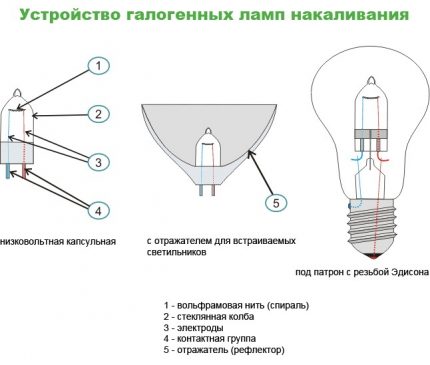
The created compounds are deposited on the inner walls, however, due to the reversibility of the process, they again decompose into the initial components under the influence of high temperatures. Tungsten atoms are released on the surface of the spiral or near it.
This feature allows you to significantly extend the time of use. Under normal conditions, the lamp lasts 2,000-4,000 hours, and when turned on smoothly, this period can be increased to 8,000-12,000 hours.
In addition, a similar process provides a special luminous flux intensity characteristic of halogens.
Technical characteristics of bulbs
Devices demonstrate the following working qualities:
- The power range varies from 1 to 20 watts.
- The luminous efficiency of such devices is 15-22 Lm / W.
- Depending on the conditions of use, the rated voltage indicator may be 6/12/24/110 / 240V.
- They withstand temperatures from -60 to +100 ° C.
- The temperature of heating the body of the filament of tungsten to 3000 ° C.
- Flask heating temperature up to 500 ° C.
- The pulsation of radiation is almost imperceptible; color rendering index tends to 100%.
- The efficiency of various types of halogen lamps is 50-80%.
Lamps designed for outdoor lighting can have large parameters of power, voltage, temperature of the spiral.
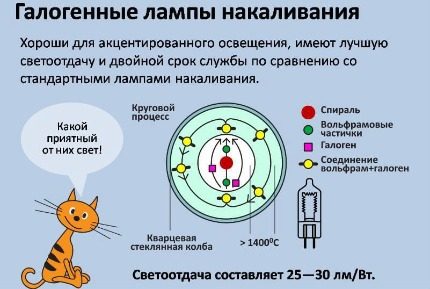
The operational requirements for this type of device that are not classified as automotive are set out in current GOST R IEC 60357-2012.
GOST R 54416-2011 (IEC 60432-3: 2002), part 3, is devoted to safety rules for the installation and operation of halogen tungsten devices.
Advantages and disadvantages of halogen
This type of lighting device has a number of undeniable advantages compared to incandescent lamps. They have a longer service life, especially subject to operating rules, as well as lower power consumption.
Due to the increased light output, the devices are characterized by a particularly bright luminous flux, which can have a warm or cold hue.
Consumers are offered a wide range of models of this type, differing in size, shape, as well as brightness and tone of the light source. This allows you to find the perfect option for highlighting any space.
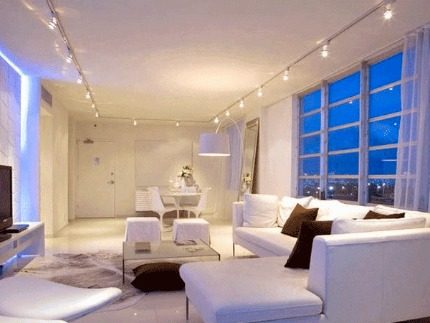
Since the use of halogens prevents the deposition of tungsten on the glass walls, such devices can be made compact. The small volume of the flask also contributes to an increase in the service life and efficiency.
The lamps in question are well tolerated by adverse environmental factors, including sudden changes in temperature. Due to this, they are great for outdoor lighting, especially if you think about their tightness.
No harmful substances are used in the construction, therefore halogen devices are considered environmentally friendly and do not require special disposal. At the same time, do not put them in glass containers, because the flasks are made of quartz material, which has other characteristics.
Halogens also have a number of serious disadvantages. When using them, the fire safety rules must be strictly observed.
Since the tungsten spiral heats the bulb strongly, such devices emit an increased amount of heat, which is why it is undesirable to install them in fusible chandeliers or other lighting devices.
It is also not recommended to mount bulbs near the ceiling; if necessary, you can use special pads.
The disadvantage of such products is also the low-frequency noise that appears in the AC network, if they are used with a dimmer.
Lamps are also sensitive to voltage drops, so it is recommended to turn them on through special transformerthat allows you to significantly increase the life of the product.
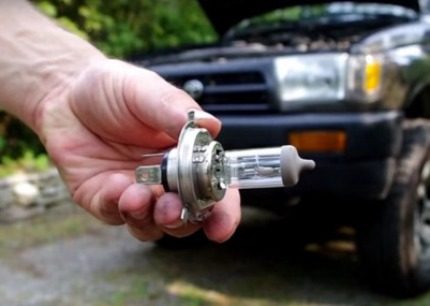
Due to the high temperature, the susceptibility of lamps to grease increases. Do not touch the surface of the flask with your bare hands, as this can cause burnout or even decay of the product.
Mount the devices with gloves or using a clean cloth. In case of accidental contact with the skin, it is advisable to immediately wipe the product with microfiber soaked in alcohol.
Varieties of halogen devices
A significant range of fixtures is on sale.Let us consider in more detail the main types.
Linear Halogen Devices
The first of the varieties of halogen lamps that appeared was created back in the 1960s. The design represents a quartz tube having double-sided leads, while the glow body is supported in the interior using special wire brackets.
Small-sized devices have significant power - 1-20 kW, which is why they are practically not used in rooms - they are mainly used for outdoor lighting, inserted into floodlights.
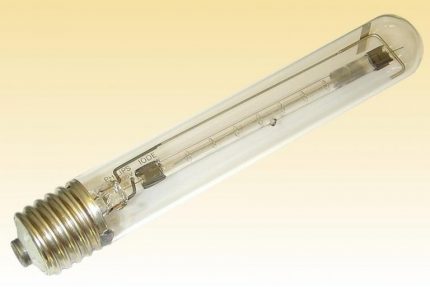
Devices of this type are available in standard lengths; the most popular are modifications with indicators of 78 and 118 mm. Most linear devices, including the popular version with R7s sockets located on both ends, assume a horizontal arrangement.
Halogens with an external bulb
Mains voltage devices are intended for direct replacement incandescent lamps. They are equipped with glass caps mounted on standard socles E14, E27.
In the inner space there is a halogen device with a quartz lamp, designed for a voltage of 220 V. The outer shell of glass protects the smaller quartz flask from accidental contact and contamination.
Devices can be of various shapes and have different options for caps: matting, transparent, dairy. There are also modifications with glass that absorbs UV radiation.
Compared to traditional incandescent devices, halogens have better color rendering, as they give a luminous flux of high color t - 2900-3000 Kelvin.

Since the lamps are connected to the network without a transformer, the period of their service directly depends on the performance of the supply device.
It is advisable to connect them through a protective unit that provides a smooth start without a sharp increase in power at the time of switching on. The same specialized device will allow you to level out possible voltage drops.
Directional lamps with reflectors
The design of this variety of devices consists of a small bulb equipped with a special reflector. It redistributes the light rays sent by the device located in the center.
Reflectors can be made of different materials, but the most popular elements are aluminum.
There are several options for such lamps, available in standard sizes MR8, MR11, MR16. The most popular is the latest modification with a bulb diameter of 50 millimeters. Models also vary in angle of emission.
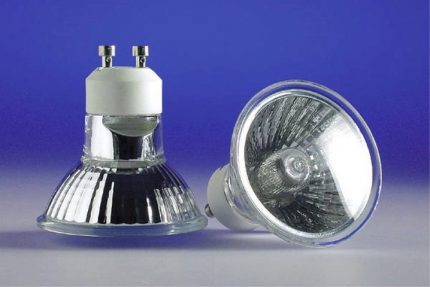
As with all halogen devices, this category is characterized by large heat transfer, with thermal radiation directed forward. If this effect is undesirable, you can use models whose reflectors remove heat back.
Devices with reflectors can be both low-voltage, designed for 6, 12, 24 V, and high-voltage, powered by a network. In the first case, they are equipped with two-pin connectors GY4, GZ4, GU4, GX5,3, GU5,3, GY6,35, in the second socket G9, G10.
Sockets of low-voltage halogen bulbs with reflectors - 6, 12, 24 V - can have various two-pin connectors. In this case, the numbers indicate the distance between the pins.
One of the most popular varieties of halogen lamps is 12 Volt halogens. Read more about them in this stuff.
An innovative type of reflex luminaires are IRC-halogen. A special coating is applied to their flask, which does not transmit infrared radiation from the tungsten spiral, but reflects back onto the filament body.
This allows you to reduce heat transfer, so that energy consumption is reduced by almost half.
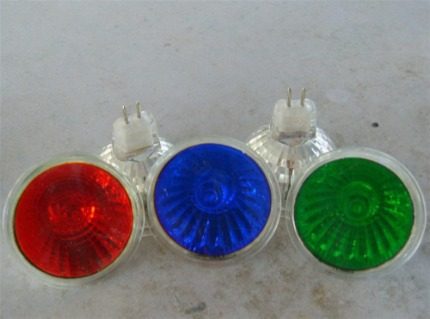
Halogen devices with a reflector are considered the most fireproof. The envisaged heat removal process prevents the heating of nearby surfaces.
Capsule or finger modifications
This type of lamp is a miniature capsule with leads, while the filament can be arranged either transversely or longitudinally, depending on the model. Suitable for use in open luminaires without protective caps.
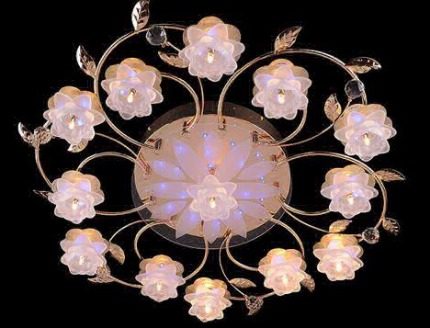
For this category of bulbs, the socles G4, G5.3, GY6.35 are used. The most popular are the G9 mains voltage devices, which are widely used both for decorative purposes and for organizing work lighting.
The nuances of choosing a halogen
Lamps should only be bought after acquiring a lighting fixture or thinking through a lighting scheme in the event of a suspended or suspended ceiling.
It is important to consider the following factors:
- type of lamp;
- size of flask and cap;
- device power;
- Operating conditions.
When choosing, you must first pay attention to what kind of bulbs are compatible with the purchased lamp. What can be learned from the instructions attached to it.
The base also requires attention - a structural part designed to be fixed in a cartridge. This element, made of heat-resistant materials, contains contacts through which an electric current is supplied to power the device.
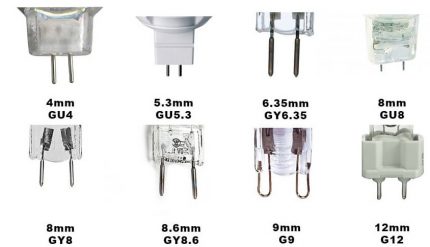
Among the most sought after options are the G9; G4; R7S; GU10:
- Model G4 differs in compact sizes. Such lamps are used for spot lighting or backlighting. They have a long service life, which is why they are quite popular.
- Products with the G9 cap were also spread. They are suitable for installation in decorative lighting fixtures and are designed to operate on AC 220 V networks.
- For quartz halogen lamps, the R7S cap is characteristic. Compact and lightweight devices are most often used in high-intensity installations.
- Instruments with a GU10 cap are equipped with a thickened contact end, providing a rotary connection to the cartridge. This type of apparatus is connected to a 220-volt network without a transformer.
There is an article on our website where we examined in detail the types of lamp socket bases. For acquaintance pass on the link.
It is also important to consider the upcoming connection diagram, which is determined by the voltage level of the lamp. The need to use a power supply during installation depends on this.
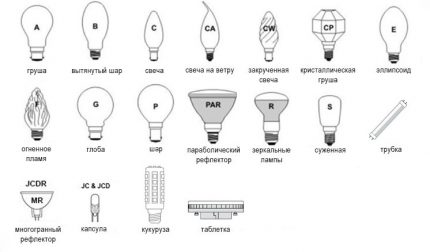
High voltage or low voltage products may be used in the circuits. The first operate directly from the mains with a voltage of 220 V, so they can be connected without using additional units. Most fit well with dimmers.
Low-voltage devices include devices whose operation is possible from a voltage of 6, 12, 24 V. To connect them, you need to use a transformer or a power supply that plays the role of a stabilizer, while several lamps can work from one device at once.
Low voltage halogens consume significantly less electricity. They are difficult to combine with ordinary types of dimmers, however, the intensity of the glow can be changed using a transformer.
Capsule models are often used for decorative lighting, but can also be used for basic lighting. The most economical products are those with reflectors, especially IRC devices.
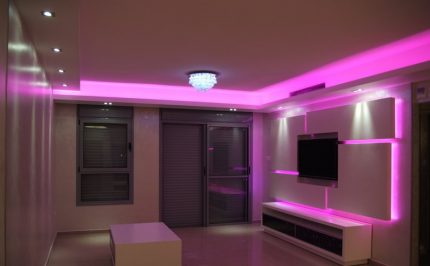
To prevent heating, it is necessary to take into account that the bulbs are at a certain distance from the walls of the lamp and ceiling.
When organizing outdoor lighting, it is better to pay attention to linear fixtures. They have increased strength and intense glow.
Overview of the best manufacturers
Among the manufacturers of the best types of halogen lamps, one can name such authoritative companies as:
- Osram;
- Philips
- Navigator
- Camelion.
Osram. This is a famous German company, which was founded at the end of the XIX century. Now high-tech products are manufactured at 48 factories located in 17 countries, while exports are carried out to 150 countries.
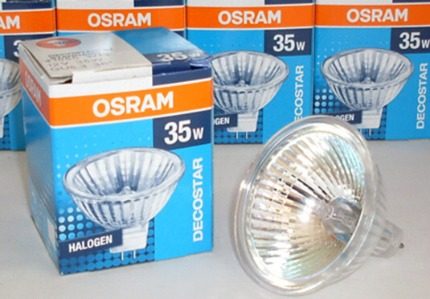
Among the wide range of products there are several hundred different types of halogen products, which differ in type - capsule, linear, with an external bulb. They vary in size, design, power, type of cap.
Philips. The Netherlands concern, established in 1891. Currently, it is one of the leaders in the production of lighting products.
A huge selection of halogens is presented in the catalogs, among them models of a traditional form, capsule and reflex devices that give intense light that allows you to illuminate any corner of the house.
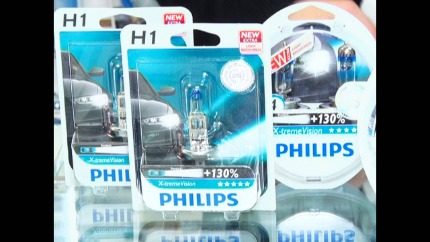
Also available are models with brightness control, as well as halogen headlights. The latter are equipped with a special ultraviolet filter, which prevents yellowing of headlights.
According to the manufacturer, the driver’s eyes in this case do not get tired, which has a beneficial effect on traffic safety.
Navigator. The history of the brand started in 1993. Initially, the company was engaged in the launch of products of other companies on the market, but since 2006 it has been engaged in the manufacture of its own products. For this, high-tech production lines were created in Klin.

Now the assortment includes lamps of various types, including all kinds of halogens, designed for indoor and outdoor lighting.
Camelion. A world-famous brand with a distribution network of partners in 80 countries on all continents. The brand entered the market in 1997, and soon it managed to take a leading position in the Russian Federation, Belarus and other CIS countries.
In addition, the company became the official supplier of the global Carrefour network. The catalogs contain more than 1000 names of various types of products, including light sources for industrial and domestic purposes, lamps of various types, control devices and others.
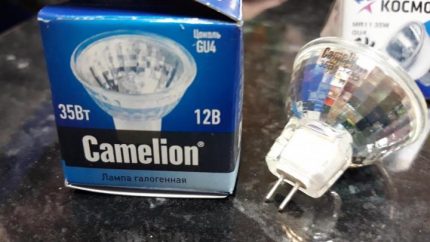
The company pays fundamental importance to the quality of manufactured products, which are subjected to repeated inspections both in its own laboratory and in certification centers of the Russian Federation.
Specialists conduct a careful selection of parts and components, as well as monitor all stages of production.
Conclusions and useful video on the topic
In the presented video you can hear a detailed story about halogen light sources:
Video review of the most popular halogens used in residential premises:
Information on the rules for the operation of a halogen bulb, observing which you can extend its life:
Lamps whose bulbs are filled with halogens are distinguished by good working qualities, which allows them to be widely used in everyday life and in industry. Enterprises produce numerous lines of similar products, varying in design, power, size.
A wide range allows you to choose an option that is ideally suited to specific requirements. It is important only to comprehensively consider the features of the proposed devices.
Do you have experience using halogen light sources? Tell us which lamp manufacturer you gave your preference to and what guided you when choosing. Please leave your comments, share experiences, ask questions in the block under the article.

 Compact fluorescent lamps: varieties + an overview of the best manufacturers
Compact fluorescent lamps: varieties + an overview of the best manufacturers 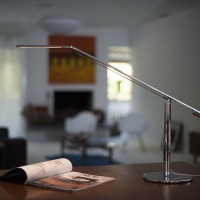 LED table lamps: types, selection rules + review of the best manufacturers
LED table lamps: types, selection rules + review of the best manufacturers 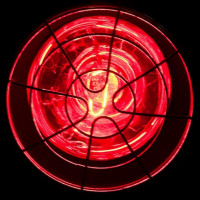 Household infrared lamps: how to choose an IR bulb + a review of the best manufacturers
Household infrared lamps: how to choose an IR bulb + a review of the best manufacturers 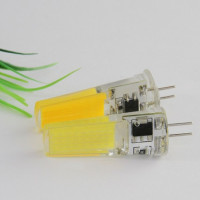 LED bulbs g4 to 12v: features, rules of choice + review of the best manufacturers
LED bulbs g4 to 12v: features, rules of choice + review of the best manufacturers 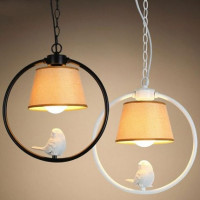 220V LED lamps: characteristics, marking, selection criteria + review of the best brands
220V LED lamps: characteristics, marking, selection criteria + review of the best brands 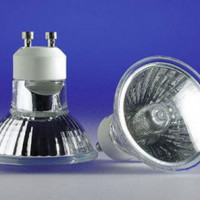 12 Volt Halogen Lamps: Overview, Features + Overview of Leading Manufacturers
12 Volt Halogen Lamps: Overview, Features + Overview of Leading Manufacturers  How much does it cost to connect gas to a private house: the price of organizing gas supply
How much does it cost to connect gas to a private house: the price of organizing gas supply  The best washing machines with dryer: model rating and customer tips
The best washing machines with dryer: model rating and customer tips  What is the color temperature of light and the nuances of choosing the temperature of the lamps to suit your needs
What is the color temperature of light and the nuances of choosing the temperature of the lamps to suit your needs  Replacement of a geyser in an apartment: replacement paperwork + basic norms and requirements
Replacement of a geyser in an apartment: replacement paperwork + basic norms and requirements
It's funny, but I heard about them for the first time. I used to buy only incandescent lamps, in the house I gradually switched to energy-saving ones, well, there’s a chandelier with LED lights, but I’m not very happy with them.
Now I’m interested in halogens, I already looked at the price - it’s quite acceptable, and the service life cannot but rejoice. I think to install a couple in the utility rooms and see how they will behave.
It seems to me that halogen lamps are too much for a home. I can’t imagine for what purpose the house will need lighting of such brightness. And the halogens shine very brightly, I used such bulbs in my car. Yes, they were of high brightness there, but ordinary ones, if I’m not mistaken, are superior to other lamps in emitted light. Plus they are heated very much, besides the high price.
And what will prevent them from being used at home? I am going to put halogen lamps in spotlights. I saw these with friends - it looks wonderful, they shine brightly.